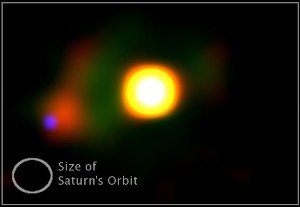15 January 2007
 |
A color image of the Mira system constructed from an archival Hubble Space Telescope image |
An international team of astronomers have observed what they believe could be the formation of a new class of planetary system around one of the most well studied stars in the galaxy.
Professor Peter Tuthill from the University's School of Physics and Sydney graduate Michael Ireland (who is now working at the Californian Institute of Technology) are part of a team that has shown that material from the dying star Mira A is being captured into in a disk around Mira B, its companion.
This observation is particularly exciting as astronomers have traditionally assumed that the dusty disks where planets form are only found around young stars in stellar nurseries, and this is the first time that a protoplanetary disk has been found in the environment of a dying star.
Mira, which was christened the 'miracle star' was first observed around 400 years ago and is located around 350 light years away in the constellation of Cetus. The star is visible to the naked eye for around a month at a time due to its changing brightness, reappearing on an 11 month cycle.
The star, which was once very similar to our sun, is now a dying and is losing its dusty outer layer at a rate of around one Earth mass every seven years. The researchers have calculated that around one per cent of this material is being captured in the gravitational field of its companion star Mira B.
Observations using new imaging methods were made at the 10 meter Keck I telescope in Hawaii and the 8 meter Gemini South telescope in Chile and revealed new details that were thought to be impossible to detect due to the blurring by atmospheric turbulence.
The intense radiation from Mira A, which is 5,000 times brighter than the sun, heats the edge of the disk to about Earth's temperature and causes it to glow in the infrared. The researchers were able to show that the material was indeed the edge of a disk and not just a "clump" in the wind from Mira A. By Modelling the way that this system captures the outflow from Mira A, the researchers we also bale to confirm that Mira B is simply an ordinary star like the sun, although about half as massive.
'Observing Mira in the infrared is like staring straight down the barrel of one of the brightest searchlights in the galaxy. It came as a real revelation to see this faint mote of dust, harbouring all the new possibilities of new worlds in formation, against the hostile environment of the Red Giant,' said Professor Tuthill.
'This research opens up new ways to search for new planets, by searching in double star systems that contain white dwarfs, said Ireland. 'The expected abundance of these systems means that we can find planets that we know are young around stars like our sun.'
'Astronomers associate the death of a star with the death of its planetary system. Here, the opposite is happening, with an ageing star laying the foundation for a new generation of planets,' said Ireland.
The team announced its findings at the most recent meeting of the American Astronomical Society.
Contact: Jake O'Shaughnessy
Phone: +61 2 9351 4312 or 0421 617 861
Email: jacob@media.usyd.edu.au



